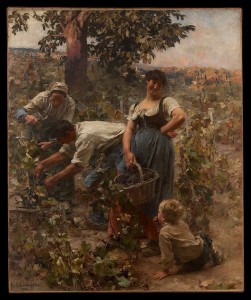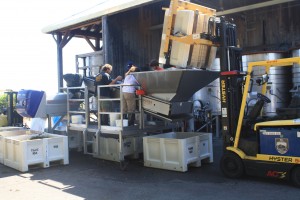September is a wonderful time of year to go wine tasting. Wine is necessarily grown in warm climates, and by September the heat has slackened a bit so it’s more comfortable to pass through the vineyards. And even better you’re there to watch the process of transforming agriculture into art: harvesting grapes, pressing them and turning them into wine. There’s something romantic about watching grapes being picked, placed in baskets and walked over to nearby trucks that will soon be piled high heading to the press pads.
 Léon-Augustin L’Hermitte, the Grape Harvest, courtesy of the Metropolitan Museum of Art
Léon-Augustin L’Hermitte, the Grape Harvest, courtesy of the Metropolitan Museum of Art
September is a terrible time to go wine tasting. There is a constant threat of rain. The roads that were never too easy to travel at the best of times are packed with trucks that are heading, full of grapes, to the wineries. Even worse, you get to be a witness to the transformation of art into industry, turning nature’s bounty into a factory product. If you get there on the right day, you might still be able to see vines with great clusters hanging from them. A day later and the vines are bare. And all you can see as you watch the grapes being harvested are ill-treated migrant farm workers.
 The crush at Saintsbury winery
The crush at Saintsbury winery
Okay, you must be asking, which is it? Is harvest time a good time to go to Wine Country or not. And the answer, of course, is both. (If you’re going wine tasting in Australia, Chile, Argentina or South Africa, harvest is likely to be in February or March, but let’s keep this simple.)
For personal and business reasons, we often travel in September and our voyages almost always include wine tasting. This works better in especially hot years; the 2014 harvest in Northern California began in July in some vineyards. Thank you, global warming. August is the usual time to pick grapes in much of Italy. So we have experienced all the positives and negatives of the vendange, as the French would put it.
The biggest question is how does the time of year affect the wine tasting experience. If you’re traveling in an area where the wineries you’d like to visit are large, well-funded and likely to derive significant revenue from vinotourism, your wine tasting experience should be only minimally affected. They have lots of bottles on hand and the tasting room employees are servers, unlikely to be in the fields filling baskets. But you may not find all the wines you’d like to taste because they have all been previously consumed. Worst of all, you may find that some wineries are closed, because they have sold out the previous year’s wines and haven’t made this year’s yet. We encountered this in California’s Central Coast at Linne Calodo and Booker wineries in 2011. So call before you go.
In areas where the wineries are all or mostly small family affairs, you are indeed more likely to find the doors locked while moms, dads, kids and cousins are out in the vineyards bringing in the crops. This recently occurred when we were out tasting in Beaujolais. “Desolé, monsieur” a somewhat grimy teenager would shrug. The only choice left to us was to taste the wines served in the local cooperatives. These are open in all seasons and you do get a good education about the grapes and winemaking practices of the area. Unfortunately, the wines most of them pour are good but hardly representative of the quality that attracted you to that region of Wine Country to begin with.
Should you go wine tasting at harvest time? Yes, you should, because you should experience all the seasons that pass through Wine Country. Each month has its attractions and drawbacks, so there’s no perfect time of year. All the same, if you are new to the fun of wine tasting, it might be better to hold off on being a “part” of the crush until you know better what you are likely to get.